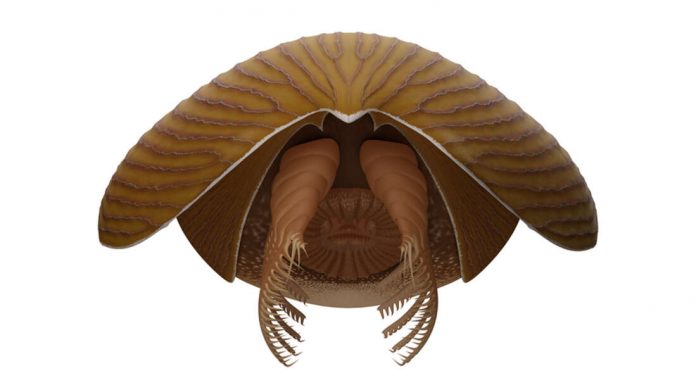The Cambrian Era, when animal life exploded into stunning diversity 541-485 million years ago, has surprised biologists once again. The latest discovery is Titanokorys gainesi, a creature that today would be notable for its shape, but then stood out for its enormous size, relative to the small animals of its time.
“The sheer size of this animal is absolutely mind-boggling,” says Jean-Bernard Caron, from the Royal Ontario Museum (ROM) in Canada. “This is one of the biggest animals from the Cambrian period ever found.”
The Cambrian period spanned from around 541 to 485 million years ago. It was a critical time in the evolution of life on Earth because it marked a massive explosion in diversity, with most of the major groups of animals we know today emerging, from arthropods and molluscs to echinoderms and chordates (us).
This new fossil, Titanokorys, belongs to a group of very early arthropods called radiodonts. It had compound eyes, a tooth-lined mouth, “flaps” for swimming, and spiny claws to capture prey.
According to co-author Joe Moysiuk from ROM and the University of Toronto, the species also had “an incredibly long head covered by a three-part carapace that took on myriad shapes. The head is so long relative to the body that these animals are really little more than swimming heads.”
A carapace is a hard shell – think of a tortoise, crab or lobster. Why some radiodonts developed a huge array of types of carapaces isn’t yet well-understood.
Since the carapace of Titanokorys was broad and flattened, palaeontologists think the creature lived on the seafloor.
“These enigmatic animals certainly had a big impact on Cambrian seafloor ecosystems,” says Caron. “Their limbs at the front looked like multiple stacked rakes and would have been very efficient at bringing anything they captured in their tiny spines towards the mouth.”
Radiodonts include some of the earliest large predators on Earth.
According to Diego Garcia-Bellido, an expert in the Cambrian period from the University of Adelaide and the South Australian Museum, this study adds much-needed information about the predators of this ancient underwater world.
“It’s like knowing about lions or tigers or great white sharks – they tell you a lot about the whole trophic web,” he explains. “The Cambrian is the time where all of these groups appear – in particular, the anomalocaridids [radiodonts] are the apex predators of the time.
“And what is becoming surprising is that there’s many of them…. There’s a whole range of very successful groups of these early arthropods.”
Garcia-Bellido notes that many of these early creatures are soft-bodied organisms and are only preserved in exceptional circumstances – particularly in specific rock formations in Canada, China and Australia.
These new fossils of Titanokorys were discovered in the Burgess Shale formation in northern Kootenay National Park, in the Canadian Rockies. Palaeontologists have previously found another interesting species here: Cambroraster falcatus, named after the Millenium Falcon.
Another iconic representative of the radiodonts is Anomalocaris (“abnormal shrimp”), an apex predator which would have dwarfed Titanokorys at nearly one metre in length. A fossil site at Emu Bay on Kangaroo Island in Australia, where Garcia-Bellido works, has previously revealed excellent examples of this animal, including evidence for very early compound eyes.
“What we have in South Australia – that not even the Burgess Shale has – are those multifaceted eyes,” he says. “We have those lenses preserved, and [other researchers] only know about that because of comparison with our specimens.”
Multifaceted eyes, also known as compound eyes, have many lenses that enable an animal to see in better resolution; imagine the eyes of insects and crustaceans, for example.
“It’s typical of predators,” Garcia-Bellido says. “That allows them to see the prey before the prey sees them. It’s pushing evolution forward because of competition.”
The findings were published in the journal Royal Society Open Science.





























